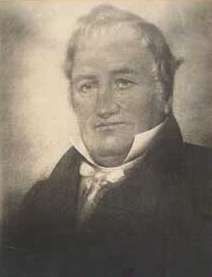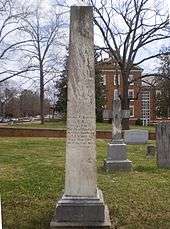George A. Baxter
George Addison Baxter (July 22, 1771 – April 24, 1841) was an American university administrator. He served as the President of Washington and Lee University from 1799 to 1829 and Hampden–Sydney College in 1835.[3]
George Addison Baxter | |
|---|---|
 | |
| 5th President of Washington & Lee University | |
| In office 1799–1829 | |
| Preceded by | Samuel Legrand Campbell |
| Succeeded by | Henry Ruffner |
| President of Hampden–Sydney College | |
| In office 1835–1835 | |
| Preceded by | Jonathan P. Cushing |
| Succeeded by | Daniel Lynn Carroll |
| Personal details | |
| Born | July 22, 1771 Rockingham County, Virginia |
| Died | April 24, 1841 (aged 69)[1] |
| Alma mater | Washington & Lee University University of North Carolina[2] |
| Profession | Theologian, Educator |
Early and family life
George Addison Baxter was born on July 22, 1771 to George Baxter and Mary Love in the Shenandoah Valley of Virginia. He graduated from Liberty Hall (renamed Washington College in 1813, now Washington and Lee University). He married Annie C. Fleming (1801-1870), the daughter of frontier patriot and former Virginia governor William Fleming, who would survive him.
Career

Baxter became a professor at his alma mater, Liberty Hall, in 1798. He served as its president from 1799 to 1829. In 1832, he became a professor at Union Theological Seminary in Prince Edward County, Virginia (now Union Presbyterian Seminary in Richmond). In 1812, he received an honorary Doctorate of Divinity from the University of North Carolina at Chapel Hill.
In 1835, Baxter served as acting president of Hampden–Sydney College.[4]
His publications include An Essay on the Abolition of Slavery, published in Richmond in 1836. It argued that slaves were better off in slavery than they would be in freedom. It was a response to the rising tide of abolitionist action, especially Brown University's President Francis Wayland. Baxter is buried in Prince Edward County, Virginia.[5]
Death and legacy
Baxter died in 1841. His family home, Baxter House near Edom, Virginia was listed on the National Register of Historic Places in 1973.[6]
References
- Kaleidoscope. 1895. Hampden–Sydney, VA: Hampden–Sydney College. 1895. p. 16. Retrieved 26 August 2016.
- Kaleidoscope. 1895. Hampden–Sydney, VA: Hampden–Sydney College. 1895. p. 16. Retrieved 26 August 2016.
- Kaleidoscope. 1895. Hampden-Sydney College
- Foote, William Henry (1856-01-01). Sketches of Virginia: Historical and Biographical. 2d ser. J.B. Lippincott & Company.
- Annals of the American Pulpit: Presbyterian, 1859, by William Buell Sprague
- "National Register Information System". National Register of Historic Places. National Park Service. July 9, 2010.
Further reading
- "George Addison Baxter" in A Copious Fountain: A History of Union Presbyterian Seminary, 1812-2012, by William B. Sweetser Jr.
| Academic offices | ||
|---|---|---|
| Preceded by Samuel Legrand Campbell |
President of Washington and Lee University 1799—1829 |
Succeeded by Henry Ruffner |
| Preceded by Jonathan P. Cushing |
President of Hampden–Sydney College 1835 |
Succeeded by Daniel Lynn Carroll |